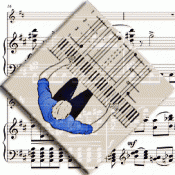
As beginners, children and adult piano students bring different mental abilities to the task of understanding music notation. As a result, I expect different paths for each group. Adults understand the concepts of note and rhythm faster than children do. They should, for adults’ minds, unlike children’s, are conceptual in nature. On the other hand, it’s hard for adults to grasp that notation is ultimately about sound and physical action. Conceptual understanding is the mere tip of the iceberg and few adult beginners understand this.
The Adult Student’s Perception of Notation
Adults tend to perceive notation as discreet, with each note representing one element, similar to perceiving each letter of a word as one element. While this is true, the meaning only becomes apparent when elements are combined. As letters form syllables, then words, and then sentences, so it is with notes. Single notes combine to form chords, then phrases, and then periods.
It is in this combination of elements that problems emerge. Beginning adult students have difficulty converting the notation into the flow of music. They feel each note or chord is a task unto itself and this is apparent in the way they move their hands and arms. At the completion of each, there is a pause in their movement. There is no physical flow from one to the next. It’s as if they stop and say, “Ah, got that one. What’s next?” This is the unconscious understanding adults bring to their work with notation.
Try reading out loud, stopping your tongue between each syllable. It sounds like someone first learning to read aloud. A similar disjointed quality in playing is common among beginners of all ages but adults seem unable to give up this micro-control and move on to develop the smoother flow of music.
Developing Musical Flow
Children develop musical flow more naturally than adults. They are always integrating and re-integrating their physical motions until early adulthood. As children’s bodies grow into adulthood, changes in proportion, size, chemistry and mental abilities force a constant biological re-integration of all their basic physical maneuvers. This constant re-integration takes place in the process of their piano-playing as well. Adults are not biologically forced into this re-integration so they must work with a conscious intent.
For adults, solutions to this problem include utilizing the previously mentioned reading exercise. Adults seem to instantly recognize the similarity between their playing and this reading style. Another remedy is to have adult students play a series of melodic notes with a relaxed hand using only one finger so that they begin to get the feeling of a constant, flowing arm motion. It takes time and work for them to get that feeling but a reminder of a stone skipping across the water can be helpful. If the stone skipped the way they play, it would sink and go “glug” at each note. The skipping stone never stops. It always leads to the next point of contact.
Empowering Adults
Teachers do not ask children to understand the treble and bass clef and all the different rhythms at their first lessons. Instead, we give them a few notes and a couple of rhythmic values and let them understand this as their mind and bodies will.
When I teach adults, I do much the same thing. I do explain the system of notation but I also tell them the limitations of this knowledge. I explain that their usual conceptual competence is not enough for this task and that they need to think of their learning as they have not done for years. I tell them they must learn as children learn, by getting the feel of the piano, the feel of what their eyes are telling them to do, and the feel of their hands doing what their ears hear. It’s about the hands and arms learning very tricky physical maneuvers that are best learned without too much thinking. Conceptual thinking quickly becomes interference to the development of the automatic motions of flow. My adult students don’t resent this approach. They understand (at least conceptually) that it makes sense to work this way with simple pieces. When they get irritated and impatient, they can back off and be a little more self-understanding.
When this course is followed, I find that adults need not be limited to chord pieces and “popular” tunes, though many of them believe that’s all they are capable of when they first start lessons. Adults need to be empowered. Children know they will be great some day. Adults have learned they are merely ordinary and dare not hope for too much. It is our job to convince them they are capable of anything most youngsters are if they are willing to work with as much hope, energy, earnestness and dedication.
*Written by Matthew Harre for Keyboard Companion. The article is reprinted with permission from the Spring, 2004 issue of Keyboard Companion, a quarterly publication for keyboard teachers, adult students and parents of young students. The Frances Clark Center for Keyboard Pedagogy published Keyboard Companion, which is now called Clavier Companion. Subscription information for Clavier Companion is available by phone: 800-824-5087 or, e-mail: circulation@keyboardcompanion.com or online at http://keyboardcompanion.com/
